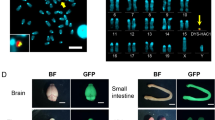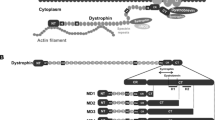Abstract
DUCHENNE'S muscular dystrophy (DMD), which affects one in 3,500 males, causes progressive myopathy of skeletal and cardiac muscles and premature death1. One approach to treatment would be to introduce the normal dystrophin gene into diseased muscle cells. When pure plasmid DNA is injected into rodent skeletal2 or cardiac muscle3–5, the cells express reporter genes. We now show that a 12-kilobase full-length human dystrophin complemen-tary DNA gene and a 6.3-kilobase Becker-like gene6 can be expressed in cultured cells and in vivo. When the human dystrophin expression plasmids are injected intramuscularly into dystrophin-deficient mdx mice, the human dystrophin proteins are present in the cytoplasm and sarcolemma of ∼1% of the myofibres. Myofibres expressing human dystrophin contain an increased proportion of peripheral nuclei. The results indicate that transfer of the dystrophin gene into the myofibres of DMD patients could be beneficial, but a larger number of genetically modified myofibres will be necessary for clinical efficacy.
This is a preview of subscription content, access via your institution
Access options
Subscribe to this journal
Receive 51 print issues and online access
$199.00 per year
only $3.90 per issue
Buy this article
- Purchase on Springer Link
- Instant access to full article PDF
Prices may be subject to local taxes which are calculated during checkout
Similar content being viewed by others
References
Wessel, H. B. Pedia. Neurol. 6, 3–12 (1990).
Wolff, J. A. et al. Science 247, 1465–1468 (1990).
Acsadi, G. et al. New Biol. 3, 71–81 (1991).
Lin, H., Parmacek, M. S., Marle, G., Boiling, S. & Leiden, J. M. Circulation 82, 2217–2221 (1990).
Kitsis, R. et al. Proc. natn. Acad. Sci. U.S.A. 88, 4138–4142 (1991).
England, S. B. et al. Nature 343, 180–182 (1990).
Dickson, G. et al. Human Genetics (in the press).
Lee, C. C., Pearlman, J. A., Chamberlain, J. S. & Caskey, C. T. Nature 349, 334–336 (1991).
Hoffman, E. P., Morgan, J. E., Watkins, S. C. & Partridge, T. A. J. Neurol. Sci. 99, 9–25 (1990).
Gorman, C. M. et al. Proc. natn. Acad. Sci. U.S.A. 79, 6777–6781 (1982).
Koenig, M. & Kunkel, L. M. J. biol. Chem. 265, 4560–4566 (1990).
Hoffman, E. P., Brown, R. & Kunkel, L. M. Cell 51, 919–928 (1987).
Lidov, H. G. W., Byers, T. J., Watkins, S. C. & Kunkel, L. M. Nature 348, 725–728 (1990).
Ellis, J. M. et al. Lancet 336, 881–882 (1990).
Ervasti, J. M., Ohlendieck, K., Kahl, S. D., Gaver, M. G. & Campbell, K. P. Nature 345, 315–319 (1990).
Ohlendieck, K., Ervasti, J. M., Snook, J. B. & Campbell, K. P. J. Cell Biol. 112, 135–148 (1990).
Wang, A. M. & Mark, D. F. in PCR Protocols (eds Innis, M. A., Gelfand, D. H., Sninsky, J. J. & White, T. J.) 70–75 (Acaemic, San Diego, 1990).
Tanabe, T., Esaki, K. & Nomura, T. Acta Neuropath. 69, 91–95 (1986).
Torres, L. F. & Duchen, L. W. Brain 110, 269–299 (1987).
Coulton, G. R., Morgan, J. E., Partridge, T. A. & Sloper, J. C. J. Neuropath. appl. Neurobiol. 14, 53–70 (1988).
Morgan, J. E., Hoffman, E. P. & Partridge, T. A. J. Cell Biol. 111, 2437–2449 (1990).
Karpati, G. et al. Am. J. Pathol. 135, 27–32 (1989).
Partridge, T. A., Morgan, J. E., Coulton, G. R., Hoffman, E. P. & Kunkel, L. M. Nature 337, 176–179 (1989).
Norton, P. A. & Coffin, J. M. Molec. Cell. Biol. 5, 281–290 (1985).
Koenig, M., Monaco, A. P. & Kunkel, L. M. Cell 53, 219–228 (1988).
Forrest, S. M. et al. Genomics 2, 109–114 (1988).
Love, D. R. et al. Proc. natn. Acad. Sci. U.S.A. 88, 3243–3247 (1991).
Feigner, P. L. et al. Proc. natn. Acad. Sci. U.S.A. 84, 7413–7417 (1987).
Fritz, J. D., Swartz, D. R. & Greaser, M. L. Analyt. Biochem. 180, 205–210 (1989).
Wolff, J. A. et al. Biotechniques (in the press).
Author information
Authors and Affiliations
Rights and permissions
About this article
Cite this article
Acsadi, G., Dickson, G., Love, D. et al. Human dystrophin expression in mdx mice after intramuscular injection of DNA constructs. Nature 352, 815–818 (1991). https://doi.org/10.1038/352815a0
Received:
Accepted:
Issue Date:
DOI: https://doi.org/10.1038/352815a0
This article is cited by
-
Advances in gene therapy for neurogenetic diseases: a brief review
Journal of Molecular Medicine (2022)
-
Generation and characterization of novel anti-DR4 and anti-DR5 antibodies developed by genetic immunization
Cell Death & Disease (2019)
-
Antibody production by in vivo RNA transfection
Scientific Reports (2017)
-
Human artificial chromosomes for Duchenne muscular dystrophy and beyond: challenges and hopes
Chromosome Research (2015)
-
Signs of Progress in Gene Therapy for Muscular Dystrophy Also Warrant Caution
Molecular Therapy (2012)
Comments
By submitting a comment you agree to abide by our Terms and Community Guidelines. If you find something abusive or that does not comply with our terms or guidelines please flag it as inappropriate.



